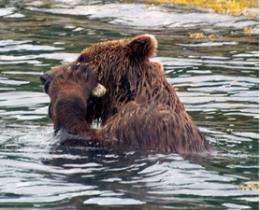March 7, 2012 report
Wild brown bear observed using a tool

(PhysOrg.com) -- Because brown bears are so reclusive, not to mention dangerous to be around, not a lot is really known about their brain power. This is actually rather odd because bears have the largest brains for their body size of all carnivores and are thought to be rather clever, though mostly through anecdotal evidence. Now comes news of British researcher Volker Deecke of the University of Cumbria, who while on vacation in Alaska, came across a brown bear using a rock covered with barnacles to help alleviate the itch associated with molting. Deecke photographed the use of the tool by the bear and has published his findings in Animal Cognition.
Bears of many varieties have very often been seen rubbing themselves against trees and rocks to help ease the itching that results when they replace their winter fur with a lighter summer coat. But never before has a bear of any kind been spotted picking up rocks to use as tools to help them better get at those places that itch. In fact, this discovery is only the fourth observed use of tools by any non-primate animal. Elephants commonly use branches to ward off flies and dolphins have been caught using sponges to hide their rostrum and some whales use bubbles to help in catching fish. Using a rock specifically chosen to perform a certain task, however, is clearly a demonstration of higher intelligence.
Deecke, who normally studies whales, was watching a couple of brown bears feed on a whale carcass on the shores of Glacier Bay, when one of them began searching the bottom of the sea for something. A moment later, the bear reached down and grabbed a rock, which Deecke could clearly see was covered with barnacles, and began rubbing it against its face and neck. Thus it appeared that not just any rock would do, it had to be covered with barnacles which would do a better job in scratching. It wasn’t just a fluke either. After a while, the bear dropped the rock, moseyed around, and after some time searched for and retrieved another rock. In all the bear repeated the whole exercise three times, retrieving three different rocks, all covered with barnacles, which he used for scratching at his itchy hide. Deecke also noted that the bear manipulated the rock in his paw before scratching, moving it into the optimal position for the best possible scratch, a type of activity previously only seen with humans and other primates.
Deecke suggests that more research ought to be focused on bears because clearly they are capable of far more than has been realized.
More information: Tool-use in the brown bear (Ursus arctos), Animal Cognition, DOI: 10.1007/s10071-012-0475-0
Abstract
This is the first report of tool-using behaviour in a wild brown bear (Ursus arctos). Whereas the use of tools is comparatively common among primates and has also been documented in several species of birds, fishes and invertebrates, tool-using behaviours have so far been observed in only four species of non-primate mammal. The observation was made and photographed while studying the behaviour of a subadult brown bear in south-eastern Alaska. The animal repeatedly picked up barnacle-encrusted rocks in shallow water, manipulated and re-oriented them in its forepaws, and used them to rub its neck and muzzle. The behaviour probably served to relieve irritated skin or to remove food-remains from the fur. Bears habitually rub against stationary objects and overturn rocks and boulders during foraging and such rubbing behaviour could have been transferred to a freely movable object to classify as tool-use. The bear exhibited considerable motor skills when manipulating the rocks, which clearly shows that these animals possess the advanced motor learning necessary for tool-use. Advanced spatial cognition and motor skills for object manipulation during feeding and tool-use provide a possible explanation for why bears have the largest brains relative to body size of all carnivores. Systematic research into the cognitive abilities of bears, both in captivity and in the wild, is clearly warranted to fully understand their motor-learning skills and physical intelligence related to tool-use and other object manipulation tasks.
© 2011 PhysOrg.com














